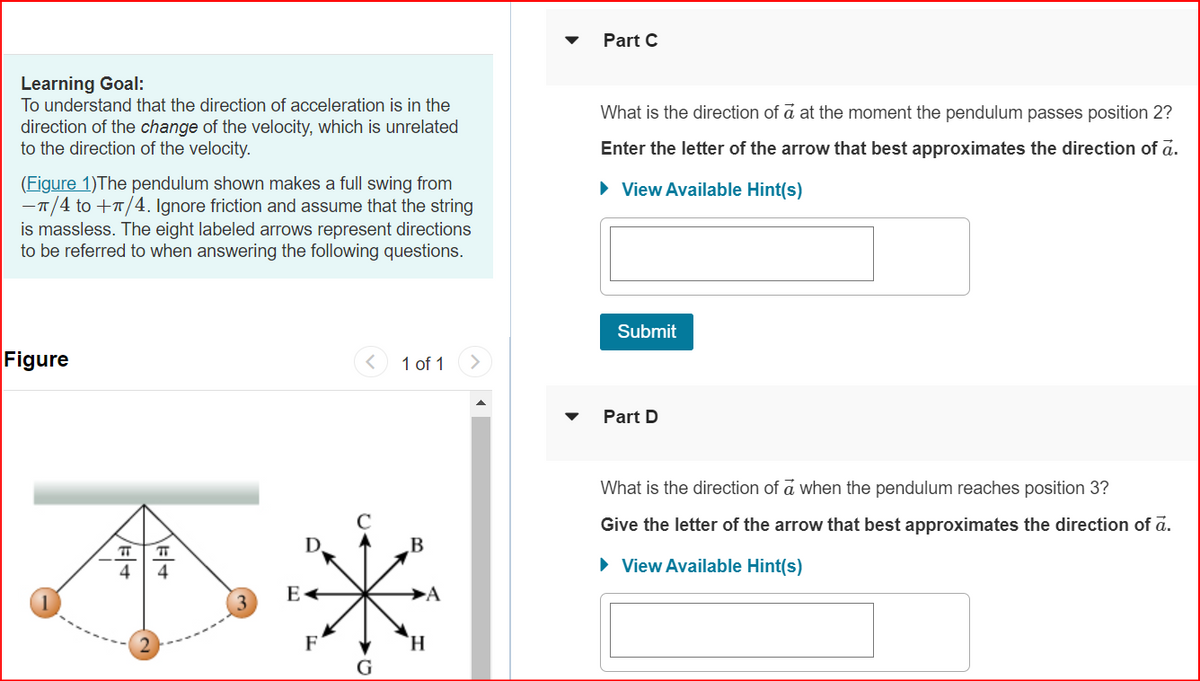Learning Goal: To understand that the direction of acceleration is in the direction of the change of the velocity, which is unrelated to the direction of the velocity. (Figure 1)The pendulum shown makes a full swing from -π/4 to +π/4. Ignore friction and assume that the string is massless. The eight labeled arrows represent directions to be referred to when answering the following questions. Figure /E/+ E+ 4 4 E- G 1 of 1 B A H Part C What is the direction of a at the moment the pendulum passes position 2? Enter the letter of the arrow that best approximates the direction of a. ► View Available Hint(s) Submit Part D What is the direction of a when the pendulum reaches position 3? Give the letter of the arrow that best approximates the direction of a. ► View Available Hint(s)
Learning Goal: To understand that the direction of acceleration is in the direction of the change of the velocity, which is unrelated to the direction of the velocity. (Figure 1)The pendulum shown makes a full swing from -π/4 to +π/4. Ignore friction and assume that the string is massless. The eight labeled arrows represent directions to be referred to when answering the following questions. Figure /E/+ E+ 4 4 E- G 1 of 1 B A H Part C What is the direction of a at the moment the pendulum passes position 2? Enter the letter of the arrow that best approximates the direction of a. ► View Available Hint(s) Submit Part D What is the direction of a when the pendulum reaches position 3? Give the letter of the arrow that best approximates the direction of a. ► View Available Hint(s)
University Physics Volume 1
18th Edition
ISBN:9781938168277
Author:William Moebs, Samuel J. Ling, Jeff Sanny
Publisher:William Moebs, Samuel J. Ling, Jeff Sanny
Chapter9: Linear Momentum And Collisions
Section: Chapter Questions
Problem 9.1CYU: Check Your Understanding The U.S. Air Force uses “10gs” (an acceleration equal to 109.8m/s2 ) as the...
Related questions
Topic Video
Question

Transcribed Image Text:Learning Goal:
To understand that the direction of acceleration is in the
direction of the change of the velocity, which is unrelated
to the direction of the velocity.
(Figure 1) The pendulum shown makes a full swing from
-π/4 to +π/4. Ignore friction and assume that the string
is massless. The eight labeled arrows represent directions
to be referred to when answering the following questions.
Figure
√El+
71
E-
F
1 of 1
B
A
H
Part C
What is the direction of a at the moment the pendulum passes position 2?
Enter the letter of the arrow that best approximates the direction of a.
► View Available Hint(s)
Submit
Part D
What is the direction of a when the pendulum reaches position 3?
Give the letter of the arrow that best approximates the direction of a.
► View Available Hint(s)
Expert Solution
Step 1
C)
At position 2, there is no tangential acceleration. There is only centripetal acceleration which acts toward the center. So, the direction of the acceleration at position 2 will be in the upward direction i.e. toward C.
Trending now
This is a popular solution!
Step by step
Solved in 2 steps

Knowledge Booster
Learn more about
Need a deep-dive on the concept behind this application? Look no further. Learn more about this topic, physics and related others by exploring similar questions and additional content below.Recommended textbooks for you

University Physics Volume 1
Physics
ISBN:
9781938168277
Author:
William Moebs, Samuel J. Ling, Jeff Sanny
Publisher:
OpenStax - Rice University


Glencoe Physics: Principles and Problems, Student…
Physics
ISBN:
9780078807213
Author:
Paul W. Zitzewitz
Publisher:
Glencoe/McGraw-Hill

University Physics Volume 1
Physics
ISBN:
9781938168277
Author:
William Moebs, Samuel J. Ling, Jeff Sanny
Publisher:
OpenStax - Rice University


Glencoe Physics: Principles and Problems, Student…
Physics
ISBN:
9780078807213
Author:
Paul W. Zitzewitz
Publisher:
Glencoe/McGraw-Hill

College Physics
Physics
ISBN:
9781938168000
Author:
Paul Peter Urone, Roger Hinrichs
Publisher:
OpenStax College

College Physics
Physics
ISBN:
9781305952300
Author:
Raymond A. Serway, Chris Vuille
Publisher:
Cengage Learning